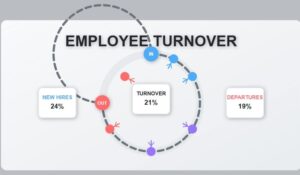The human resources (HR) industry is undergoing a significant transformation. Thanks to the proliferation of new HR tools and trends. In 2024, the name of the game is personalization. Employees increasingly expect an employee-friendly environment, where they participate in the decision-making process by sharing their thoughts with business leaders. Technology will play a key role here, as the use of real-time analytics, the application of gamified systems, and big data will drive employee appreciation and employee satisfaction.
In particular, feedback HR tools will energize a workforce that likes to know how they’re doing, regularly and if possible in real-time. The new year isn’t going to change any of that. In fact, according to Deloitte, there’s going to be an actual explosion of feedback, pulse survey, and analytics tools.
HR professionals need to keep pace with these developments to ensure that they stay relevant and competitive in the marketplace. In this article, we will explore
15 Trends that will Shape HR in 2024
HR Trend 1: Artificial Intelligence (AI)
AI is already making a significant impact on HR, and it will continue to do so in the coming years. HR professionals can use AI to automate tasks like resume screening and scheduling interviews, freeing up time for more strategic initiatives. AI can also help identify patterns in employee behavior that can inform decisions around retention and development.
2: Big Data Analytics
With data security and privacy laws being passed all over the world, every organization needs to take data privacy more seriously. HR professionals can use big data analytics to gain insights into employee performance, engagement, and satisfaction. By analyzing data from sources like employee surveys and social media, HR professionals can identify trends and make data-driven decisions about training and development, recruitment, and retention.
HR Trend 3: Virtual Reality (VR)
VR technology can provide employees with immersive training experiences that are more engaging and memorable than traditional training methods. For example, VR can be used to simulate realistic workplace scenarios, allowing employees to practice and refine their skills in a safe and controlled environment.
4: Remote Work HR Tools
The pandemic has forced many organizations to embrace remote work, and this trend is likely to continue into the future. As such, HR professionals need to have the tools and strategies in place to support remote employees effectively. This includes communication tools like video conferencing, project management tools, and collaboration platforms.
HR Trend 5: Employee Experience Platforms
An employee experience platform (EXP) is an HR tool that helps organizations manage the employee experience from onboarding to offboarding. EXPs can help HR professionals automate tasks like sending welcome emails and scheduling training sessions, freeing up time for more strategic initiatives. EXPs can also help HR professionals monitor employee sentiment and engagement, making it easier to identify and address issues before they become bigger problems.
6: Personalization
Just as customers expect a personalized experience, employees also expect a workplace that is tailored to their needs and preferences. In 2024, HR professionals will need to focus on personalization to attract and retain top talent. This includes providing flexible work arrangements, personalized training and development programs, and recognition programs that cater to individual needs.
HR Trend 7: Wellness Technology
As organizations become more aware of the importance of employee well-being, wellness technology will become increasingly important in 2024. This includes tools like wearables that track employee health and fitness, mental health apps, and virtual wellness programs. By investing in wellness technology, HR professionals can promote a healthier, more productive workforce.
8: Gamification
In 2024, gamification is expected to play a crucial role in HR as it can be used to enhance employee engagement, motivation, and learning. Gamification involves the incorporation of game-like elements into non-game activities, such as training and development programs. By making these activities more interactive and fun, gamification can help employees stay engaged and motivated, resulting in better learning outcomes and improved performance.
Gamification can also be used to promote a positive workplace culture. By incorporating elements of healthy competition and teamwork into the workplace, gamification can help foster a sense of community and collaboration among employees. This can lead to a more positive and supportive work environment, which in turn can improve employee morale and job satisfaction. Gamification also aligns well with trends like skills-based hiring, where companies prioritize a candidate’s capabilities and demonstrated skills over traditional hiring methods. Furthermore, gamification can be used to recognize and reward employees for their achievements, further promoting a positive workplace culture that values and celebrates success.
Overall, gamification is an important HR tool in 2024 that can be used to enhance employee engagement, motivation, and learning, as well as promote a positive workplace culture. By incorporating game-like elements into non-game activities, HR professionals can help employees stay engaged and motivated, resulting in better learning outcomes and improved performance. Additionally, gamification can be used to foster a sense of community and collaboration among employees, leading to a more positive and supportive work environment.
HR Trend 9: Diversity, Equity, and Inclusion (DEI)
Diversity, equity, and inclusion (DEI) is a critical HR tool in 2024, as businesses are recognizing the importance of creating a diverse and inclusive workplace culture. Companies that prioritize DEI have been shown to have higher employee engagement, improved productivity, and increased profitability. With an increasingly diverse workforce, it is important for HR professionals to implement DEI initiatives that promote fairness and equality, while also creating a sense of belonging for all employees.
In 2024, HR professionals will need to focus on implementing DEI strategies that go beyond just checking boxes and quotas. This will involve creating an inclusive workplace culture where employees feel valued and respected for their unique perspectives and contributions. This can be achieved through initiatives such as unconscious bias training, mentorship programs, and employee resource groups that provide a safe space for employees to share their experiences and ideas. By prioritizing DEI, HR professionals can create a workplace where all employees can thrive and contribute to the success of the company.
10: People Analytics
People analytics, also known as HR analytics, is a rapidly maturing field that is becoming increasingly essential for HR professionals in 2024. With the growing need for comprehensive and measurable employee engagement efforts, people analytics provides a powerful HR tool for human resource managers to better understand their workforce and make data-driven decisions. By leveraging advanced data analytics techniques, HR professionals can gain insights into workforce trends, employee satisfaction levels, and areas of potential improvement.
People analytics can help HR professionals to identify the root causes of employee turnover, absenteeism, and other workplace issues. By analyzing data on employee performance, satisfaction, and engagement, HR professionals can identify trends and patterns that may indicate areas of concern. This information can be used to develop targeted interventions and strategies to address these issues and improve overall employee well-being.
People analytics can also be used to support strategic decision-making within organizations. By analyzing workforce data alongside business performance data, HR professionals can identify opportunities for growth and development, as well as potential risks and threats. This information can be used to develop effective strategies to support organizational goals and objectives, while also ensuring that the workforce is aligned with these goals.
11: Blockchain
Blockchain technology, the underlying technology behind cryptocurrencies, has the potential to transform a wide range of industries, including human resources. One of the most promising applications of blockchain in HR is streamlining the process of background checks and verification of credentials. By using blockchain, HR professionals can create a secure and transparent system that reduces the risk of fraud and errors.
Traditionally, background checks and verification of credentials have been time-consuming and costly processes. They involve contacting various institutions, such as schools, universities, and previous employers, to verify the information provided by candidates. This process is prone to errors and fraud, which can result in serious consequences for both employees and employers.
With blockchain technology, HR professionals can create a decentralized database that contains all the information related to a candidate’s background and credentials. This information stored in a secure and tamper-proof format, makes it virtually impossible to manipulate or alter. By using blockchain, HR professionals can verify a candidate’s credentials and background quickly and securely, without the need for third-party verification services.
Another advantage of using blockchain for background checks and verification of credentials is that it eliminates the need for intermediaries. In a traditional system, background check companies and verification services act as intermediaries between employers and institutions. These intermediaries charge a fee for their services, which adds to the overall cost of the process. With blockchain, you don’t need intermediaries. This further reduces the processing cost and time.
Moreover, use blockchain technology to streamline other HR processes, such as payroll, benefits administration, and compliance management. Use self-executing smart contracts directly written into code. Automate many of these processes and reduce the risk of errors and fraud.
HR Trend 12: C-Suite and HR Collaboration
Successful companies will enjoy alignment between the C-suite and human resources. Leaders who don’t plan exactly what they want their training to accomplish are wasting resources, according to the HR Trend Institute. In a learning culture, management and HR work together to define the values, processes, and practices that increase performance and competencies. Employees who share the knowledge and skills they acquire feed a learning culture that creates a sustainable and adaptable organization.
13: Mobile content and delivery are more critical than ever.
According to a study by LinkedIn, the biggest challenge for talent development is getting employees to make time for learning. Employees would agree that they don’t have the time to take away from their primary jobs to get training. Delivering training across multiple platforms, such as classroom, mobile, and on-demand, can help eliminate the time crunch for busy employees. It also gives your employees the incentives and social interactions they need to actively engage.
14: Framing training as a valued employee benefit.
Employee learning and training can be key differentiators between companies competing for talent. Employees primarily want to work for organizations that provide personal and professional development. And they consider it a deciding factor when determining whether to stay with their current employer or move on. Leverage your training as an employee incentive. Additionally, add it to your existing benefits package alongside retirement and health and wellness options.
HR Trend 15: Making performance management a priority.
Performance management is now real-time, continuous, and integrated process. Annual performance reviews will be a thing of the past. Reviews will occur more frequently (weekly, monthly or quarterly). These reviews and check-ins help HR get more granular with performance and changes occur almost instantly as opposed to gradually. Employees are more actively aware of their own performance and improvement areas making growth more dynamic.
One HR Tool that Addresses Multiple Needs: HubEngage
There are many employee communications HR tools that let you gather data and push messages to your team. Whether they are under one roof or scattered around the world these tools can reach them. But to truly engage employees and optimize productivity, you need more than just any communications tool.
That’s why we created the HubEngage employee engagement platform. It’s built on our exclusive CoIL Engagement Framework. This framework provides four key capabilities that yield real business results. The capabilities are:
1. Inform & Inspire
Keep employees plugged in with interactive content, leadership messaging, new product/service training, and fast-track career advancement opportunities.
2. Hear Your Employees
Get employee ideas, insights, and opinions with instant feedback surveys and polls. Keep your finger on the pulse of your culture so you can stream future content that hits home.
3. Reward & Recognize
Reward and recognize employees who view and share content. Give them points that are redeemable for cash, gift cards or certificates.
4. Analyze Metrics
View employee engagement levels and identify the rate of staff satisfaction. Leverage knowledge scoring content advocacy and increase app usage. Analyze gamification stats and adapt programs for maximum performance.
Organizations need solutions that not only align with current trends but also anticipate and adapt to future needs. HR professionals who stay up to date and embrace best HR tools will deliver better results.
Want to better manage your workforce and create a more productive workplace?
Check out HubEngage: It’s more than an HR Tool
In today’s dynamic scenario, HubEngage emerges as the epitome of innovation and effectiveness. Its forward-thinking features seamlessly integrate with the trends discussed, from advanced employee engagement capabilities to personalized communication tools. The platform doesn’t just keep pace with HR trends; it sets the standard.
Experience the future of HR tools with HubEngage. Elevate your workforce management, foster engagement, and embrace the changing dynamics of the workplace. HubEngage empowers you to create a dedicated workforce and to measure the ROI of various initiatives in real time.
Ready to lead the way? Unlock the potential of HubEngage with a Free Demo – because the best tool for tomorrow’s challenges is the one that understands them today.













